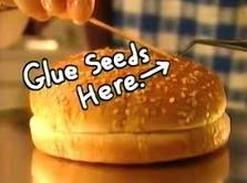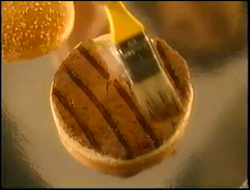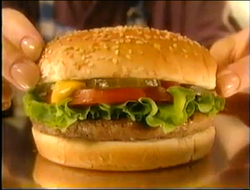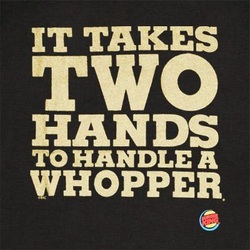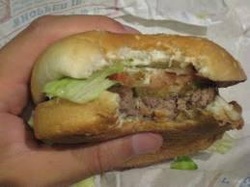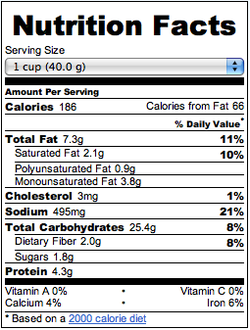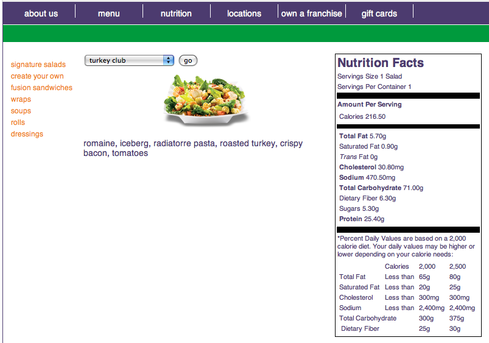Deceptions of Fast Food
Many times fast food advertising companies find different ways to mislead their customers. Many would claim these advertisers are using false advertising to sell their products. Not many people are aware or understand the meaning of false advertising. The legal definition of false advertising is the act of knowingly advertising a product or service that does not exist or does not function as represented (legaldictionary.com). What is not understood by the general public is that false advertising is a crime that can be punishable if proven guilty.
What fast food advertising actually does in their ads is they deceive you. By this I mean they mislead by a false appearance or statement. Now that sounds like the ads you see on television. You would think just something as simple as the size of burgers in ads and the size they actually are is the only thing that is misleading.
There are several different ways in which fast food deceives you. The purpose of this paper is to show three different ways fast food misleads or deceives its customers. We will focus on how the food is prepared when it is filmed for commercials, how the message they portray is never what the employees at these restaurants trained to do and how even certain fast food chains mislead with their nutritional facts.
One of the biggest ways fast food corporations deceive their consumers is through visual false advertisement. Most people would agree that the pictures of food that are shown in television advertisements look infinitely more delicious than the food that is actually served looks. When watching a commercial for a big, meaty, juicy cheeseburger, with the ketchup and mustard oozing out in just the right amount, one’s mouth starts watering just looking at the picture on the screen. However, when you go to the restaurant to buy that same cheeseburger, it is usually small, thin, and just thrown together pell-mell. Although the fact that pictures of the food are deceiving is common knowledge, what is not common knowledge is how much work goes into making the food look so irresistible on television.
There are people known as food makeup artists or food stylists, and their job is to make the food look absolutely scrumptious for the television advertisements. Shooting food is one of the hardest tasks for a photographer- hot food will cool, frozen food will melt (even more quickly than normal under the hot lights), moist food will become dry, fruit will become brown, and vegetables will wilt. To rise to these challenges, food artists use many different tools to ensure the look of delectability during the entire shoot.
Some of the tools include motor oil, a blow torch, glycerin, detergent, cotton balls, spray deodorant, hairy spray, spray fabric protector, toothpicks, safety pins, tweezers, a large syringe, brown shoe polish, incense sticks, white glue, paper towels, and sturdy cardboard. Each of these tools has a special way of tricking the naked eye. For example, motor oil is used as a shooting alternative for unphotogenic syrups. Cotton balls are used to created the illusion of steaming hot food after being soaked and nuked in the microwave. Spray fabric protector is used to stop the motor oil from soaking into the pancakes, which have blueberries strategically safety-pinned to them. Toothpicks and safety pins are also used to hold the ingredients together in those tall, fluffy burgers and sandwiches that we salivate over so often. The large syringe is used to create the busty meat look- it squirts mashed potatoes under the skin of the poultry, which is then torch-cooked. Detergent is used to make bubbles when shooting beverages. The cardboard is cut up into small squares to lay between the bun and hamburger so the grease and juices do not soak into the bread, making it soggy after the sesame seeds have been glued on.
Shocking, isn’t it? Well let’s walk through the steps of creating the perfect photography burger with food makeup artist, Jennifer Usdock. She says that “even though the burger is only on the screen for a few seconds, he’s got to look so big and juicy, that he’ll be the star of the commercial.” In order to make this possible, Jennifer only cooks the hamburger patty for twenty seconds on each side- so basically the burger is still raw. Then, to give it the look of coming off the grill, she uses steaming-hot skewers to burn “grill lines” onto the meat. Now, to give the patty the brown, plump look, Jennifer paints it with brown food coloring. After choosing the perfectly shaped bun, and strategically glueing on the sesame seeds, she puts a cardboard square on the bottom half, and then lays the uncooked, painted burger patty on it. If the burger is looking rather small at that moment, a simple cutting and spreading it from the back will fix the problem (since the burger will only be shot from one angle). Now, to dress the burger. Jennifer sorts through many heads of lettuce on ice to choose the perfect leaf. After picking all the toppings this way, she secures them and the top of the bun in place using safety pins and toothpicks. The toothpicks help keep the burger looking his tallest. And there we have it- the completely seductive burger that many of us crave after watching fast food advertisements.
Many fast food corporations give their consumers the idea that their food is made or priced a certain way but when employees are trained those messages are left out of the training. Often the misleading prices can lead a person to purchase an item and be forced to pay double. After several interviews with employees at different fast food restaurants and customers who frequent such places you realize there is huge difference in what they expect and what they get.
According to the McDonald’s website, they serve meals that are freshly made. They claim that they cook their food (especially the burgers) then only leave them out for ten minutes, throwing them out after. McDonalds serves 27 million people daily, in just the United States. To accommodate this high demand, employees must mass produce the food. So what really happens when they make 50 burgers but only sell 25 in 10 minutes?
We interviewed four different McDonalds’ employees from four different McDonalds. Danielle G works at the McDonalds in Washington Township NJ. When asked about how long the food stays out after being cooked she sat back and had to think for a minute. “We are told the burgers should be disposed of after about twenty minutes. Someone is usually assigned to keep track on how long they are out and to throw out old ones. It depends on who is working that determines if that happens.” Katie Lemourux worked at the McDonalds in Glassboro NJ and she had a different idea about what was supposed to be done with the burgers. “It wasn’t until my last week there when I had to train my replacement that I learned about having to throw out the burgers every 20 minutes. They could sit out for hours and they still gave them to customers.” So what you are reading isn’t always what you get. Our advice to you is if you do eat at McDonalds again anytime soon ask and make sure you get a new burger.
Did you also know that McDonalds uses the message that Olympic athletes eat McDonalds’ food when they are competing? They use the slogan “You don’t’ have to be and Olympic athlete to eat like one.” The commercials and advertisements they put out depict certain athletes eating and loving egg mcmuffins for French fries. The funny thing is not once do you ever see the athlete eat the food. Feel mislead? What about kids who see these commercials everyday and want to be just like their favorite athlete who says they eat McDonalds?
Do you remember when Burger King advertised their whopper that it was so big you need two hands to eat it? This advertisement caused a whopper frenzy with people going to Burger King to eat it. Well for those who didn’t eat one, the advertisers mislead consumers again. Surprised? Now the whopper is a rather large sandwich with a lot packed into it. Doing our own personal research, a whopper proved to be pretty messy. Two whoppers were purchased from two different locations and they certainly did not need two hands to eat it. After discussing this little devastating to fact to Frank Santoro, an employee at Burger King he made this reference. “Food is made quickly to satisfy the customer right then and there. We don’t focus on how large to make it but to make sure everything that is supposed to be on the sandwich gets on there. There are times that we are in such a rush that I’m surprised the sandwich doesn’t fall apart on the costumer.”
According to the McDonald’s website, they serve meals that are freshly made. They claim that they cook their food (especially the burgers) then only leave them out for ten minutes, throwing them out after. McDonalds serves 27 million people daily, in just the United States. To accommodate this high demand, employees must mass produce the food. So what really happens when they make 50 burgers but only sell 25 in 10 minutes?
We interviewed four different McDonalds’ employees from four different McDonalds. Danielle G works at the McDonalds in Washington Township NJ. When asked about how long the food stays out after being cooked she sat back and had to think for a minute. “We are told the burgers should be disposed of after about twenty minutes. Someone is usually assigned to keep track on how long they are out and to throw out old ones. It depends on who is working that determines if that happens.” Katie Lemourux worked at the McDonalds in Glassboro NJ and she had a different idea about what was supposed to be done with the burgers. “It wasn’t until my last week there when I had to train my replacement that I learned about having to throw out the burgers every 20 minutes. They could sit out for hours and they still gave them to customers.” So what you are reading isn’t always what you get. Our advice to you is if you do eat at McDonalds again anytime soon ask and make sure you get a new burger.
Did you also know that McDonalds uses the message that Olympic athletes eat McDonalds’ food when they are competing? They use the slogan “You don’t’ have to be and Olympic athlete to eat like one.” The commercials and advertisements they put out depict certain athletes eating and loving egg mcmuffins for French fries. The funny thing is not once do you ever see the athlete eat the food. Feel mislead? What about kids who see these commercials everyday and want to be just like their favorite athlete who says they eat McDonalds?
Do you remember when Burger King advertised their whopper that it was so big you need two hands to eat it? This advertisement caused a whopper frenzy with people going to Burger King to eat it. Well for those who didn’t eat one, the advertisers mislead consumers again. Surprised? Now the whopper is a rather large sandwich with a lot packed into it. Doing our own personal research, a whopper proved to be pretty messy. Two whoppers were purchased from two different locations and they certainly did not need two hands to eat it. After discussing this little devastating to fact to Frank Santoro, an employee at Burger King he made this reference. “Food is made quickly to satisfy the customer right then and there. We don’t focus on how large to make it but to make sure everything that is supposed to be on the sandwich gets on there. There are times that we are in such a rush that I’m surprised the sandwich doesn’t fall apart on the costumer.”
Burger King and Taco Bell are both becoming increasingly guilty with their misleading prices on signs and even commercials. A large number of issues about Burger King or Taco Bell found on complaints.com are about the misleading prices. There were several complaints stating that they would read a banner that was hung on the outside of building saying a specific meal was only $4.00. When that meal was purchased the employee rang up $5.50. After the person complained, the employee said they had no idea about the sign and that it must be old because it is not being sold for that price. Other complaints say commercials especially Taco Bell ones are advertising a burrito for $.89. When customers would go in to purchase the burrito they were informed that the commercial was old and they are no longer having that sale. Burger King had the same complaint about their whopper meals that were being advertised for two dollars cheaper then sale price. After an interview with Burger King employee Frank Santoro, he told us that many times employees and managers have no idea about deals that are being advertised. “People would come in and argue they just saw a commercial for a whopper meal being $3.75. We would all argue saying they are mistaken because we are not running that promotion. About two days later a call from corp. would come in and tell us ‘O yea hey we have been having this promotion for like a week so make sure you change your prices.’ I would get so angry because of the lack of communication.”
Saladworks are very misleading to their customers and even to their employees. The salad works mission statement on their website reads; ‘The idea of Saladworks is to provide fanatic’ly fresh, made to order, entrée-sized salads as an alternative food offering for consumers on the go. The website also has a nutrition tab where you can see the calorie in-take for every salad. What you don’t see on this salad is how much they are putting in it to give you the calorie in-take. If you look on a box of cereal, a bag of chips or on a soft drink bottle you will see how many calories per serving (i.e. 1 cup, 15 chips, 8 fluid oz). The calorie in-take on Saladworks website only says per salad.
According to WebMD an adult person should consume 1800 calories daily spread equally between five meals. This would equal a person having about 360 calories per meal. All of the salads on the website are less than 500 calories, healthy right? One would think.
Saladworks are very misleading to their customers and even to their employees. The salad works mission statement on their website reads; ‘The idea of Saladworks is to provide fanatic’ly fresh, made to order, entrée-sized salads as an alternative food offering for consumers on the go. The website also has a nutrition tab where you can see the calorie in-take for every salad. What you don’t see on this salad is how much they are putting in it to give you the calorie in-take. If you look on a box of cereal, a bag of chips or on a soft drink bottle you will see how many calories per serving (i.e. 1 cup, 15 chips, 8 fluid oz). The calorie in-take on Saladworks website only says per salad.
According to WebMD an adult person should consume 1800 calories daily spread equally between five meals. This would equal a person having about 360 calories per meal. All of the salads on the website are less than 500 calories, healthy right? One would think.
Upon this observation I asked a Saladworks employee Brittany Defeo about how she was taught to make the salads. When I asked about the nutrition facts she claimed she didn’t even realize Saladworks did that on the website. She asked a few extra employees around her who also didn’t know. She began to explain; “I was trained to make the salad and to put different foods in there. But everybody has a different hand so some are more on the heavier side than others. I was only told two grabs of lettuce but not exactly how much. The people always thought any salad we make is less than 500 calories. But they don’t realize how much is being put into it. I was taught to put two to three scoops in of what is essential to the salad. That is never made clear that the extras are in Saladworks’ case extremely extra. The dressing should only be two tablespoons but our spoon is larger than that and I was taught to give two scoops. When the salad is done it is closer to 1000 calories not 500.”
What should Saladworks do? Make correct facts on their website. They need to inform their consumer exactly how much they should have in order to keep the calories low. Employees must also be trained to meet the needs of the customer.
Misleading advertising has been around for so long and will be around long after all of us are gone. The purpose of this paper was to shed a little light on what the advertising companies of fast food corporations actually do to mislead so you can take it into your own hands and make a better decision for yourself.
What should Saladworks do? Make correct facts on their website. They need to inform their consumer exactly how much they should have in order to keep the calories low. Employees must also be trained to meet the needs of the customer.
Misleading advertising has been around for so long and will be around long after all of us are gone. The purpose of this paper was to shed a little light on what the advertising companies of fast food corporations actually do to mislead so you can take it into your own hands and make a better decision for yourself.


